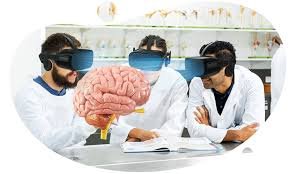How is virtual reality being used in education and training?
How is virtual reality being used in education and training?
Virtual reality has opened up exciting possibilities for education and training, offering immersive and interactive experiences that can enhance learning outcomes. Here are some of the ways virtual reality is being used in education and training.
.jpg)
- Simulations: Virtual reality simulations can replicate real-life scenarios and allow students to practice skills and problem-solving in a safe and controlled environment. This can be particularly useful in fields such as medicine, where students can practice procedures without risk to real patients.
- Field trips: Virtual reality can provide students with access to locations and experiences that may be difficult or impossible to access in real life. For example, students can visit historical sites, explore different cultures, or experience life in space.
- Language learning: Virtual reality can create immersive language-learning environments where students can practice speaking and listening skills with virtual characters in real-life scenarios.
- Job training: Virtual reality can be used to train employees in a range of fields, from construction to hospitality. By simulating on-the-job scenarios, employees can learn skills and procedures in a safe and controlled environment.
- Accessibility: Virtual reality can provide access to education and training for people who may face physical or geographical barriers. This includes people with disabilities or those in remote location.

- Science and engineering: Virtual reality can provide students with a better understanding of complex scientific and engineering concepts, such as molecular biology or astrophysics. By creating 3D models and simulations, students can interact with and manipulate objects in a way that is not possible with traditional teaching methods.
- Soft skills: Virtual reality can be used to train soft skills, such as communication and teamwork. By simulating real-life scenarios, students can practice skills and receive feedback in a safe and controlled environment.
- Cultural sensitivity: Virtual reality can be used to promote cultural sensitivity and understanding. By experiencing different cultures and perspectives, students can develop empathy and a broader worldview.
- Personalized learning: Virtual reality can provide personalized learning experiences by adapting to individual student needs and preference. By monitoring students interactions, virtual reality programs can adjust content and difficulty to ensures optimal learning outcomes.
- Research: Virtual reality is also being used as a tool for research. By creating virtual environments, researchers can study human behavior and interaction in a controlled setting, allowing for more accurate and detailed data collection.
As virtual reality technology continues to advance, it has the potential to revolutionize education and training, providing more engaging, effective, and accessible learning experience for students of all ages and backgrounds.